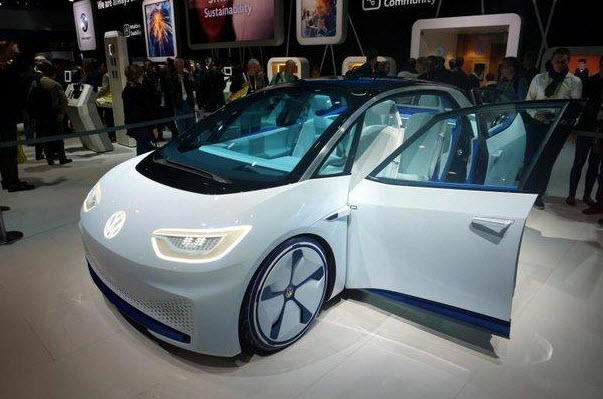| Year | 2017-01-11 |
|---|
WICHSINEE WIBULPOLPRASERT
SUNTHORN TUNMUNTONG
Here comes an inconvenient truth for the global automotive industry: The globe is warming and technology is progressing rapidly.
Countries around the world are starting to demand next-generation automobiles with high-tech and environmentally friendly features that few traditional automakers are able to accommodate.
This opens up opportunities for players outside the auto industry to offer new technologies for new automobile models, many of which are warmly welcomed by governments and consumers alike.

There are two trends shaping next-generation automobiles.
The first one is more strict environmental standards to be imposed in many countries as a result of the global effort to curb climate change and cut carbon emissions.
This movement puts traditional automotive technology in a difficult spot. A recent series of intentional cheating scandals by leading German and Japanese automakers indicates that fossil-fueled, combustion-engine technology might have reached its limits. Electric-powered vehicles, ranging from hybrid vehicles, battery electric vehicles and fuelcell vehicles, are therefore in the spotlight as alternative transportation options with less or even zero pollution emissions.
The second trend is the future arrival of smarter and more connected automobiles. Connectivity and IT operations are must-have functions of future cars in order to fully satisfy consumers’ lifestyles. Think of them as smart phones or tablets on wheels. Future generations of vehicles will be developed to be connected, think, or even self-drive.
The two trends define a disruptive moment in the global auto industry. While many traditional automakers have been striving to acquire cutting-edge technology solutions, newcomers have successfully penetrated various positions in the automotive value chain. Promising examples are automobile assemblers such as Tesla Motor or BYD, battery makers such as Panasonic or LG Chem, and automotive IT developers like Google, Microsoft and Baidu. In short, the most valueadded parts for next-generation mobility are no longer made in Detroit, but in Silicon Valley, China, or even Israel.
Once dubbed the “Detroit of Asia”, how can Thailand prepare for these trends?
These disruptive forces threatening the global auto industry have already been sensed in Thailand. And as a country whose gross domestic product relies very much on exports of automobiles and auto parts as our top export products, we have already suffered a decline in exports due to the tightening automobile fuel efficiency regulation called CAFE (Corporate Average Fuel Efficiency) in key markets, especially the Middle East.
In response to the transition, the Thai government’s recent attempt to jump start the production and adoption of battery-powered electric vehicles in
Thailand seems to be a quick and correct response. However, dealing with technological changes has never been an easy task. Many lessons from the past suggest that picking the wrong technology (among competing ones) could impose heavy costs on the industry.
A recent study by the Thailand Development Research Institute (TDRI) proposes that in order to survive the transition, the Thai government and the
Thai automotive industry need to be strategic by aligning automobile industrial policy with environmental protection policy while remaining technology neutral.
First, the environmental costs of an automobile should be fully and accurately built into its price. 2015’s new automobile excise tax, (loosely) calculated based on exhaust pipe emissions, is a fairly correct turn that leads us to a greener road. However, our study shows that this new excise tax still gives some pollution-intensive automobiles a price advantage. Moreover, the excise tax rate for battery electric vehicles is set to be the same as the cleanest hybrid, even though the former has zero exhaust pipe emissions while the latter’s exhaust pipe emissions are higher.
Second, instead of making decisions on what future technologies we should adopt, Thailand should focus on becoming a production platform for advanced batteries and motors. Like the engine in the old days, batteries and motors are core components of all next-generation automobiles, including hybrid vehicles and battery-powered electric cars. Thus, planning to become a production hub for batteries and motors is considered a safe bet in the sense that it can both serve the current demand for hybrid vehicles and also the future demand for battery-powered electric vehicles.
Currently, battery manufacturing is concentrated in China, Japan, and South Korea. To take a slice of that pie, Thailand needs to move fast with a careful industrial policy that attracts the direct investment of battery companies to establish factories here.
Third, to retain the value-added chain, software, sensors, and IT parts for next-generation automobiles should be developed domestically as much as possible.
Thailand has the comparative advantage of being the largest developer of software for automobiles in Southeast Asia. Thanks to lower wages of Thai computer engineers compared to Japanese engineers, automobile software makers have increasingly outsourced certain tasks to Thailand. This high value-added process will be another key strategy for Thailand to sustain its position in the industry amidst the change.
Finally, the government should reconsider the timing of infrastructure support for batterypowered electric vehicles. Our research suggests that it will take a number of years for these vehicles to enter and occupy the mass market.
The reasons are that current battery capacity is too limited to suit the various ranges of transport needs and gasoline prices are projected to remain low for the next few years.
With that in mind, constructing too many charging facilities for battery-powered electric vehicles at this early stage might be wasteful.
Wichsinee Wibulpolprasert is a research fellow and Sunthorn Tunmuntong is a researcher at Thailand Development Research Institute (TDRI). Policy analyses from the TDRI appear in the Bangkok Post on alternate Wednesdays.
First published: Bangkok Post (Eng) Wednesday, January 11, 2017
